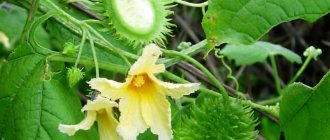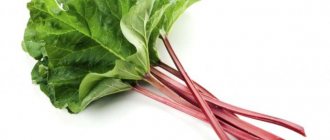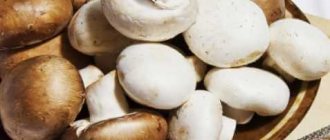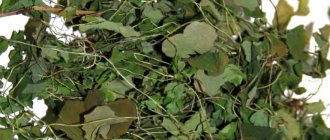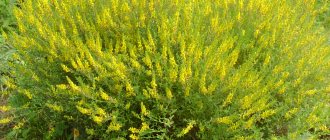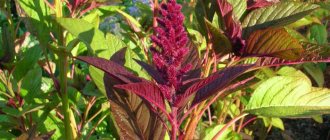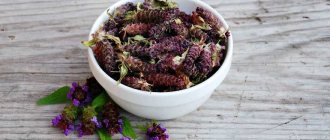Mad cucumber... When you first hear this phrase, you might think: “Really? Can plants go crazy too? At least once in our lives we come into contact with unusual plants, especially in tropical countries. Some of them look like “fairytale” species. Our cucumber is just one of these - we will talk about the mad cucumber plant. Why is it called that, and what other plants are attributed to this species, let's figure it out.
Fruits of the common mad cucumber
What is a mad cucumber
Crazy cucumber gets its name from the Greek, meaning “throw away.” Known for the characteristic type of fruit, which when ripe bursts from internal pressure, scatters seeds, and reproduction occurs. In Russia, the common mad cucumber is confused with Echinocystis, which is also a representative of the cucurbitaceae, but not poisonous.
Wild cucumber thickets
Wild cucumber loves moisture very much. The plant grows quickly; under good conditions, one representative occupies 5 square meters. The fruits have jelly-like pulp. By the time it ripens, the jelly begins to ferment, forming high pressure inside. Small cucumbers are strewn with small bristly needles, which, as they ripen, become thorns. With such devices they easily cling to clothing and animal fur.
How does a mad cucumber shoot? Breaking away from the peduncle, the fruit shoots out liquid with seeds, scattering the contents over a distance of up to six meters . The phenomenon is typical for growing vines from the end of August and in September.
Crazy cucumber shoots seeds
Therapeutic effects and contraindications of mad cucumber
A plant like the crazy cucumber, which is a member of the gourd family, is actually neither. They began to call it a cucumber due to some similarity of the above-ground part with its edible namesake. Although the fruit itself has nothing in common with a cucumber. And they began to call him mad because of the way the seeds spread. This plant is unsuitable for food, however, the beneficial properties of the mad cucumber allow it to be quite actively used as a remedy in official and folk medicine.
The common mad cucumber is the only plant of its kind: there are no other similar species. The wild cucumber stem is a vine that quickly creeps and spreads across the soil or climbs up a support. The length of the vine can reach 1.5 m. Unlike the cucumber, this plant does not have tendrils with which the vine could cling to a support.
The leaves of the plant are similar to the leaves of the well-known edible cucumber - rough, heart-shaped-ovate, grayish-felt underneath. The flowers are unisexual and monoecious, yellow in color, corolla-shaped. Blooms from July to late September. Since the flowers have absolutely no smell, they do not attract the attention of insects and are not considered honey plants.
Article on the topic: Speckled waterfall - useful properties, description
The fruit is a juicy pumpkin, which in its appearance vaguely resembles an edible cucumber. The oblong, ovoid fruits, covered with dense bristles, reach a length of no more than 6 cm. Immediately after ripening, the fruits of this plant are soft and juicy, the seeds are similar to very small sunflower seeds. Later they lengthen and become dense. The cucumber root is taproot, fleshy, whitish in color.
The common mad cucumber is found today in the Caucasus, Crimea and southern Russia. You can often observe the plant on garbage heaps, near construction sites, in landfills, near hedges and next to roads.
Botanical description
Botanical description:
- Common cucumber (Latin name Ecballium elaterium) is a herbaceous plant of the Cucurbitaceae family. He is the only representative of his kind. The plant is poisonous and can be perennial or annual.
- From a distance, the plant may look like a shrub, but it is not. The herbaceous plant has a vine-like stem, a powerful root system, large leaves with a gray edge on the underside and green on the top.
- The flowers are heterosexual, bright yellow, regular in shape and have a pleasant aroma. They sit solitarily on a long peduncle, but can be collected in inflorescences; the flowering period is from July to September.
- A shaggy, oblong-oval fruit, rather reminiscent of a large gooseberry, 3-10 cm long.
- Propagated by seeds.
Crazy cucumber (Ecballium elaterium)
A wild plant whose fruits explode when ripe. Used in folk medicine as a diuretic and laxative. The plant is poisonous!
Table of contents
Flower formula
In medicine
In traditional medicine, mad cucumber is not used. The plant is poisonous and has many contraindications, but despite its toxicity, it is actively used in folk medicine. It is used to treat: malaria, hepatitis, liver and kidney diseases, edema and dropsy, hemorrhoids, gout and rheumatism, pain and spasms in the intestines, diarrhea and amenorrhea. In small doses, cucumber helps with sinusitis, skin abscesses, open ulcers on the skin and fungal diseases.
Article on the topic: Spring primrose - beneficial properties, description
Contraindications and side effects
Crazy cucumber is a poisonous plant that is not recommended for use without consulting a specialist. The juice and pulp of the plant can cause vomiting and nausea, bloody diarrhea, headaches, dizziness, and drowsiness. If the juice gets on the skin, burns and ulcers occur.
Treatment with mad cucumber is contraindicated for pregnant and lactating women, as well as persons under the age of 18, even in small doses. It is not recommended to use crazy cucumber for any problems with the gastrointestinal tract.
You can neutralize the negative effects of mad cucumber with the help of other herbs, for example, parsley, anise, sabur. But a herbalist with extensive experience should select the right proportions. Traditional medicine can only be taken under the supervision of a physician.
Classification
Crazy cucumber (Ecballium elaterium) is an annual plant that belongs to the order Cucurbitaceae, the Cucurbitaceae family. Belongs to the genus Crazy cucumber (Ecballium), species - Crazy cucumber. There are no other representatives of this species in nature.
The peculiarity of the plant is that it throws seeds up to 20 meters when ripe. Popular names include: thorny carp, Echinocystis lobed or Echinocystis spinosum, Indian pomegranate.
Botanical description
Crazy cucumber is an annual herbaceous plant up to 50 cm high. The stem, lying on the ground, creeping, is covered with small fibers. The leaves are arranged alternately on long petioles and are heart-shaped with teeth along the edge and up to 20 centimeters in size. The edge of the leaf is green, and the base is covered with white hairs; it looks grayish in appearance.
The flowers of the plant are compound-petalled, unisexual with a slightly yellowish tint. The corolla is yellow, funnel-shaped or bell-shaped, five-parted, up to 2 cm long. Female flowers emerge from the axil one at a time. Occasionally the plant may be dioecious. Male flowers with three stamens are collected in beautiful racemes, which are located on long peduncles. Crazy cucumber flower formula: ♂* H(5) L(5) T(2+2)+1 P0; ♀* H(5) L5 T R(3).
The root of the mad cucumber is taproot, thickened, white, weakly branched and fleshy. The fruit of the plant is yellowish-green and looks like a fleshy cucumber with spines all over its surface. When ripe, the fruit is separated from its stalk with a push and pushes seeds with mucus through the hole formed at the base to a distance of more than ten meters. This occurs due to the creation of very strong pressure inside; internal mucus accumulates during growth and begins to ferment, which creates an accumulation of gas. The fruit is up to 8 cm long and 2.5-5 cm wide. The seeds have an elongated shape, they are compressed, small, smooth and narrowly bordered, reaching 4 mm in length. The crazy cucumber blooms in July-September, and the fruits ripen in August-September. Distributed over large areas, it is a weed that is difficult to remove.
Spreading
Crazy cucumber is found in Asia Minor and the Mediterranean, grows in the southern territories of Russia: in the Caucasus, Crimea, Krasnodar and Stavropol territories. Prefers sandy soils with minimal moisture. Grows on roadsides, on dry slopes, along ravines.
History, homeland and distribution
The plant received its name for its explosive method of seed propagation. If one berry explodes, then other rockets are launched by shocks of the splashed liquid, resulting in a whole fireworks display. The shock wave of cucumbers is so strong that it is quite possible to get bruised.
Young, unripe fruits of Ecballium elaterium
Ekballium, growing in the semi-deserts of the Mediterranean and Western Asia, was the first to receive this name. Avicenna (Abu Ali Ibn Sina) used it as a medicine. In his work “The Canon of Medicine,” he describes recipes for the treatment of several diseases. Only in it the plant Ecballium elaterium Rich means “donkey cucumber”.
Natural habitat is the countries of the Mediterranean Sea, Asia Minor and Central Asia, the southern part of Eastern Europe, Crimea and the Caucasus. Cucumber spreads along the coasts of the seas, in deserted, garbage areas and deposits as a weed plant.
Cross-section of the fruit of a mad cucumber
In Russia, Echinocystis became known as the mad cucumber. This plant comes from America, was introduced only a century ago, but, having gone wild, it turns from a rare plant into a real weed.
Squirting cucumber. Recipes for medicinal products
Juice from the fruit of the plant
Drink from 1 to 3 drops at a time, diluting it in 100 grams of water beforehand. Use 1-2 times a day. Therapy begins with 1 drop per 1 dose.
To cure sinusitis, dilute in a ratio of 2 drops of juice to 8 drops of boiled chilled water. Then we drop 3 drops into the nose into each nostril. The procedure is carried out 1 time per day. After you have instilled the drops, frequent sneezing may begin and then pus may develop. Next time a similar procedure can be carried out after 3 days. After 2 procedures, if the condition does not improve, then do not continue such treatment.
Mad cucumber herb infusion
Take 1 tsp. dry collection and pour 1 tbsp of hot water. Let it steep for 45 minutes in a warm place, then strain the resulting infusion. Drink 1 tsp half an hour before meals. 3 times a day
This medicinal drug is taken as a diuretic for edema, as a laxative and as a remedy against worms. It can also be used to lubricate fungal-affected areas of the skin. It helps well with high fever, sciatica, neuralgia, gout and rheumatism.
During the treatment of a poorly healing trophic ulcer, you need to mix 1 tbsp. of this infusion with 1 tsp. flour. The resulting cake is applied and bandaged to problem areas.
Oil from this plant
Take 100 ml of sunflower oil and add 1 tsp to it. small fresh or dried mad cucumber fruits. Heat the resulting mixture over low heat for 15 minutes, stirring constantly. Remove from the stove and strain through a piece of gauze. This medicine helps with hemorrhoids.
Tincture from the fruits of this plant. To do this, mix in a proportion of 1 part of the dry fruit collection and 20 parts of pure alcohol. Leave for 2 weeks, then strain. Use only externally for diagnoses such as neuralgia, rheumatism, sciatica.
Chemical composition
Despite the fact that the shooting cucumber has been familiar since the time of Avicenna, its chemical composition has not been fully studied. It is known that the stem and roots contain carotenoids, alkaloids, steroids, vitamins C and B1, organic and fatty acids, and nitrogen-containing compounds.
Crazy cucumber seeds, leaves and fruits
Mad cucumber fruits contain:
- elasericins,
- vitamins A, C, group B,
- elatherin,
- various alkaloids.
Useful qualities of culture
The crazy cucumber has an enviable range of elements and substances useful to humans:
- glycosides;
- organic acids;
- alkaloids;
- fatty acid;
- steroids;
- ascorbic acid, etc.
Main areas of therapeutic impact:
- diuretic;
- disinfectant;
- laxative;
- anthelmintic;
- antitumor.
For internal use, preparations containing cucumber are prescribed for edema, jaundice of newborns, malaria, inflammatory processes in the kidneys and liver, diarrhea, hemorrhoids, rheumatism and gout, intestinal colic and other cases. For these purposes, a fruit decoction of cucumber based on its fruits and other parts of the plant is most often used. Indications for external use: fungus on the skin, inflammation of the nasopharyngeal mucosa, trophic ulcer. In these cases, alcohol tinctures are made from dried stems, leaves, flowers and roots.
When preparing raw materials, it is better to use special drying machines. They work on the principle of ovens, but at low temperatures. The above-ground parts of the cucumber are dried in the fresh air in dry weather. Shading is necessary, since sunlight will negatively affect the quality of the product. After harvesting, the material is stored for no more than 1 year in a tightly closed container. Contact with other medicinal preparations or food is not allowed.
Attention! The mad cucumber is poisonous. Therefore, collect, process and use it in strict accordance with technology.
Possible harm and contraindications, precautions
Common cucumber is a highly poisonous plant . It should be used for medical purposes only in small doses and under medical supervision. Overdose or uncontrolled use can be fatal. A microscopic dose of fresh juice of 0.6 g will be fatal to humans.
It is necessary to supervise children in areas where the plant grows. In one of the regions of Russia, schoolgirls tried the seeds of a mad cucumber, which caused hallucinations and severe intoxication:
Two schoolgirls were poisoned by a mad cucumber
Contraindications for the use of drugs from the rabid plant are:
- all diseases of the gastrointestinal tract;
- insufficiency of cardiac activity (defects);
- breastfeeding and pregnancy;
- cannot be used by children under 14 years of age.
Procurement of raw materials
Grass (stems and leaves), unripe fruits and roots of mad cucumber are used as medicinal raw materials.
To harvest the above-ground part, the stems are cut, divided into pieces, washed and dried in the shade in dry, sunny weather. The readiness of the raw material is determined as follows: when bent, the stems should not bend, but break easily.
Article on the topic: Oak groats - useful properties, description
The roots are collected in the fall. First, they are dug up, shaken off the ground, washed with water from a cold tap, dried outside in the sun or in a room with good natural ventilation, and then dried in a dryer.
The fruits are usually used fresh to obtain juice or infusions. The fruits are dried, cut into two parts, just like the roots, after drying them in the sun.
Finished medicinal raw materials obtained from mad cucumber can be stored in a closed glass container and used for 1 year.
Interesting Facts
The restless one received its unusual name for its fruits. When they reach full ripeness, juice ferments inside them and enormous pressure arises for the plants. Some sources write about an indicator of 6 atmospheres. It is difficult to measure this, since the slightest touch to the fetus at this time causes an explosion. The jelly entrails, along with the seeds, fall on animals and people who disturb the plant, and are then spread over a long distance.
Echinocystis arch in landscape design
In the magazine “Science and Life” No. 11 for 2012 we find interesting facts about the mad cucumber. The authors explain its Latin name as follows: the generic name Ecballium comes from the Latin Ex-ballisto - to knock down with a projectile throwing stones. The epithet from elatio, in Latin, has several meanings - impulse, flight, funeral. The authors provide data on the osmotic pressure inside the fruit at 1.5 MPa (1 Pa = 10 atmospheres). Compare - there are about 2.5 atmospheres in a car tire.
There are several plants under the general name “Mad Cucumber”:
- Ekballium (the "original" crazy cucumber);
Echinocystis in a hedge
- Echinocystis (more used as an ornamental plant);
- Cyclantera (Peruvian cucumber, achoxcha cucumber) – the fruits do not explode. But they simply crack and turn out;
Fruit of cyclantera peruviana
- Cyclantera stalk - the fruits are similar to a cucumber, but with a tougher skin.
- The mad vine is very tenacious. If it is grown in a garden plot, then it is necessary to monitor the scattered seeds and promptly weed out the breeding children. Otherwise, the area will very soon become overgrown like a jungle.
